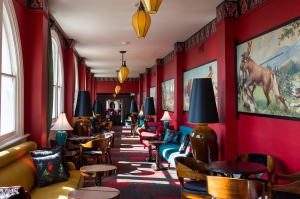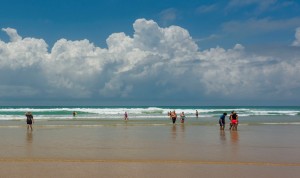
Steampunk inventor Bruce Hodsdon of Ingleburn at the 16th annual Ironfest at Lithgow Showground. Photo: David Hill, Deep Hill Media
By Ellen Hill Photos: David Hill
“We have an executioner on duty. He’s explaining his craft to someone – it seems to work.’’
Emcee Friar Craig Batty has been whipping up the peasants with outrageous one-liners for years.
“Medieval torturers: the only people allowed to be drunk at work’’; “The grandstand is a designated bomb shelter; “It’s okay to get killed, just not injured – there’s too much paperwork’’.

Steampunker Augustus Smoke at the 16th annual Ironfest at Lithgow Showground. Photo: David Hill, Deep Hill Media
He continues as the ominous vibration of a procession of World War II vehicles take to the racetrack.
“There is an attack imminent,’’ Batty blares.
“Do please cover your ears and close your mouth as the firing starts.’’
Under thunderous skies, a medieval knight decked out in iron helmet and chainmail covers his ears while a French damsel in a cylinder caul headdress takes a picture on a smart phone and gluts of Steampunkers cheer and stamp their feet, trinkets and baubles jangling and glass eye pieces glinting.
Crowds of voyeurs in jeans and caps gawp in amazement at the mish-mash of history and unabashed exhibitionism surrounding them.
“Don’t stand too close to the fence or you might get hit,’’ Batty booms.
A camera drone buzzes overhead capturing the whole spectacle.
“The aerial attack has been thwarted. The displacements from Lithgow Small Arms Factory saw them off.’’
The crowd murmurs and shuffles in anticipation for the next instalment.
“Where else can you go to have your children disembowelled?’’
The Kingdom of Ironfest, in a windswept valley in Australia’s first industrial heart, Lithgow just west of the Great Divide, that’s where.
For 16 years, long before Game of Thrones, Vikings, Marco Polo and the like, the secret lives of those who cover inhibition with costumes have been played out in a surreal real-life fantasy for all to witness at Lithgow Showground.
The “Festival with a metal edge’’ has strayed slightly from its original intention of showcasing metal art and celebrating Lithgow’s industrial heritage.
These days there are fewer medieval groups and more Steampunk. Regardless, the event attracts an ever increasing number of people eager to transform from bland to brazen.
Chainmail jewellery maker Tamara Dalrymple of Blacktown, who attended Ironfest with partner Graeme Paterson, said: “When I dress up I can be myself.’’

Kendall Bailey of Redfern in her extravagent rendition of Maleficent. Photo: David Hill, Deep Hill Media
Like every hard core cosplayer Kendall Bailey of Redfern knew her costume would create a stir amongst the watchers.
Resplendent in gold medieval-style gown, cosmetic cheekbones, towering horns and wings with a 1m span, she faced a wall of lenses at every step as her interpretation of silver screen character Maleficent.
“It’s one way you can do art without having to publish it, and everyone can enjoy it,’’ she says.
For Steampunkers Natalie and Ray Everton it’s a family activity they enjoy with sons Joshua, 16, and Fletcher, 10.
Deesh strides through the lush grass besides the row of Australian colonial era canvass tents, her navy blue medieval gown flapping in the wind, her dark hair playing around her face. She looks exquisitely regal.
Her slim frame is deceptive: Deesh is an expert – and ruthless – swordswoman, capable of packing and taking a bone-jarring wallop.

Swordsman Rob Lyon of Sydney prepares for battle. Photo: David Hill, Deep Hill Media
Partner Rob Lyon used to be satisfied playing Dungeons & Dragons.
These days, he likes a more robust game – sword play.
“Some people don’t like to be hit hard but I like to be flogged so I know I’ve been hit,’’ he says.
“You can be whatever and whoever you want to be. Some people take it to the enth degree.’’
John Pettigrew from Tamborine, Brisbane, likes the Viking era. With cascading grew/white hair and beard, he is on the road six months of the year peddling drinking horns on the re-enactors festival circuit.
“My wife passed away four years so there’s nothing to keep me at home now,’’ he says.
“I like the Viking period but I’m damn sure I wouldn’t like to live in it. The average age was only about 24; very few would have gotten to see their grandkids; there was disease everywhere. It was a hard life all round.’’
For mechanical engineer Bruce Hodsdon of Ingleburn, Steampunk is all about the detail: “Too much glass is never enough.
“I like to look at that things and think: `That can actually work’.’’
Ironfest is as much about a gathering of artists, re-enactors and cosplayers as it is about an industrial town emerging from its time languishing in the shadow of the hulking golden Greater Blue Mountains escarpment.

Viking John Pettigrew of Tamborine, Brisbane. Photo: David Hill, Deep Hill Media
Dotted with gritty industrial sites such as the Blast Furnace ruin, the Small Arms Factory and State Mine Museum, the largely working class population is reeling from the recent and imminent closures of its main employers – the coal mines and the power station.
Rather than wallowing in self-pity, Lithgow Council has implemented a range of morale-boosting initiatives.
Efforts to reinvigorate the town centre with murals, shop window displays and retail competitions aim to encourage local business while events such as Lithglo lighting show and Halloween encourage town pride and foster community spirit.
The plan has paid off, along with a new focus on local tourism.
The fact that the town’s first female Mayor Maree Statham supports these events in spectacular style must surely help too.
Magnificent in head-to-toe Steampunk costume with trademark coral coloured lipstick and immaculate coif, Madam Mayor made a jaw-dropping debut on the dress-up stage at the 2014 Ironfest and was unrecognisable in a red mask and cape at Halloween.
“I do it for Lithgow,’’ she says, again in full Steampunk attire.
The success of Ironfest, which began when metal artist Macgregor Ross convinced about 200 mates to turn up to the inaugural festival 16 years ago, is testament to that – about 16,000 attended on the April 18-19 weekend.

Detail work of the Steampunk outfit adorning the elegant Mayor of Lithgow Maree Statham. Photo: David Hill, Deep Hill Media
Icy rain begins to fall like medieval arrows from the sky, the freezing droplets stinging the eyes as they splosh on bodies unprepared for damp rising from beneath and suffocating fog bearing down from above.
Kids wearing Roman helmet-style beanies, wielding plastic swords and lance splinter mementos burrow into fleecy hoodies, stuff mottled hands into denim pockets and trudge slowly through the wrought iron gates of the showground.
Behind them, fantastic characters pull woollen capes tightly around themselves as they wander through the makeshift campground: members of Governor Lachlan Macquarie’s own 73rd Regiment in their red and white colonial uniforms chat with those of the Australian Armoured Vehicle Association while Danish wenches prepare hearty meals in cast iron pots and the kings of the joust brush down their steeds.
The stalls are battened down and the blacksmith fires doused until next time.
But next time is not next year. For these folk, Ironfest is not a one-off event. It is a mobile playground filled with every character of the imagination.

Members of the Macquarie’s 73rd Regiment re-enactment group (l-r) Simon Fowler and Lea Barnett study an antique from the period. Photo: David Hill, Deep Hill Media
The weird and the whimsical roam the nation in search of playmates.
They cross paths (and swords) at the Australian Celtic Festival at Glen Innes in April, Rowany Festival in April, My Lords and Ladies Medieval Fayre at Doonside in May, Winterfest Sydney Medieval Faire at Parramatta in June and St Ives Medieval Faire in September.
They re-convene at Abbey Medieval Festival in Queensland in July, Gumeracha Medieval Fair in South Australia in May and Balingup Medieval Carnival in Western Australia in August.
They are the ones who have courage to act out their fantasies and breathe fire through their inner St George’s dragon while the rest of us gaze with jealous eyes from beneath safe floppy fringes in wonder and wish we too could unleash our inner Captain Victoria Winter-Buckingham, don squeaky leather corsetry, adjust our decorative cogs and pose ever so politely for photos.
Go to www.ironfest.net for more information about Ironfest and Lithgow Tourism for more details on other events in the area.
Go to www.deephill.com.au to see Deep Hill Media coverage of Ironfest throughout the years.
* David and Ellen Hill received complimentary into the Ironfest event

Steampunkers and their bling. Photo: David Hill, Deep Hill Media



































































